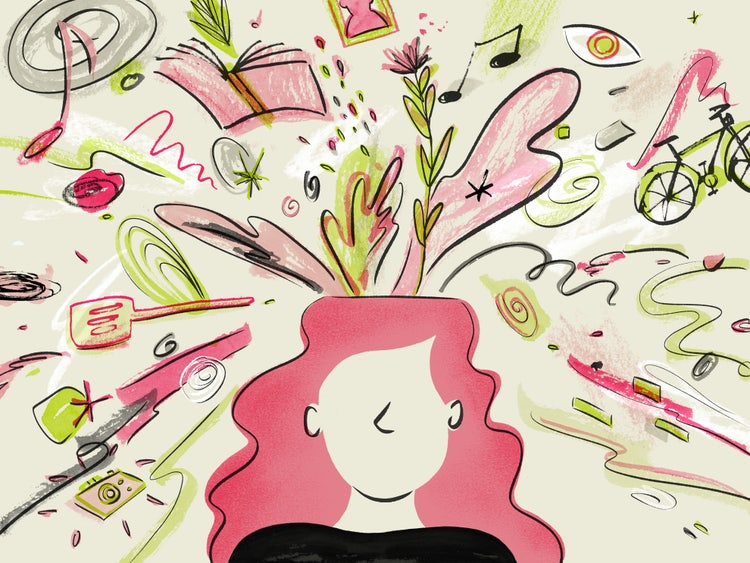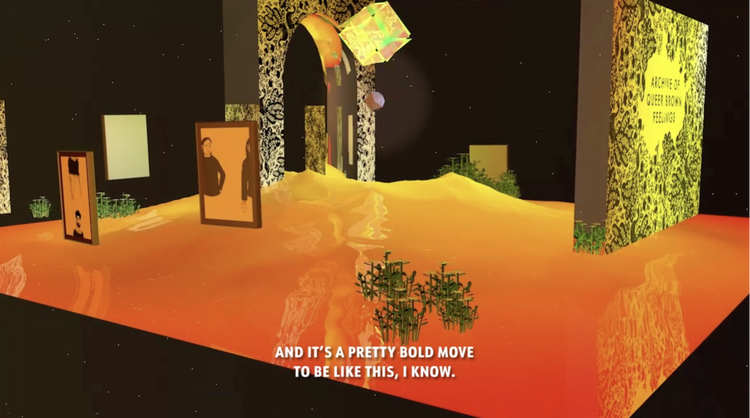Ask Adobe Design: Where do you find creative inspiration?
Our team members share their methods for keeping fresh ideas flowing

Illustration by Daniel Gray-Barnett
For this edition we asked five of our team members to share how they find inspiration and how they maintain it—at work and outside of work. For most of them, inspiration ebbs and flows but it’s never far from the surface.
“I get stuck all the time, in both my personal and professional creative work. I’ll be working along on a painting, it’s going great, I’ve got it all figured out, and then my perfect plan inexplicably falls apart. When I find myself at these impasses of existential doubt, I turn to my collections for inspiration.
“I’ve always been a collector—some might call it hoarding, but I’ll stick with the more acceptable term. I’ll see an old photo or scrap of a candy wrapper on the street and snatch it up for later. I have binders, boxes, and envelopes full of these things: Old trading cards, other people’s wedding photographs, paper plates and discarded business cards, magazines and paperback books, parts of broken toys, and campaign matchbooks from the 1968 County Commissioners Election in Nevada.


“I’m drawn to things that are a bit off kilter or that have a touch of a unique bygone Americana. Over the years I’ve developed my looking skills to a point where I can quickly decide whether something fits my aesthetic sensibility and is worth keeping around (in the limited physical and mental space of NYC, this is key). I’ve even gotten so that I can get the same jolt of inspiration from just a photo of the thing, which has also helped with the space issue. When I get stuck, I pull down a binder from the shelf, open a box, or scroll deep into my camera roll. I tend to start this process absently, just looking at all these images and things I’ve saved. Sometimes I find the perfect thing, or more often I find something that sparks another idea that either reminds me of something I’d saved in a different binder, or sends me off to web search for ‘vintage carved lamps from the 1970s.’
“In my work at Adobe I employ a similar, though more digital method to maintain inspiration. My computer is littered with screen shots and uncountable folders titled simply, ‘images.’ My virtual desktop is so cluttered that I recently installed an app, called HiddenMe, to hide its contents completely most of the time, making it a much more effective junk drawer of inspiration materials. So here again when I get stuck, I’ll look through folders of snippets of amazing UI designs others have done, intermixed with doctored images of Mr. Spock, and start to piece together a new idea. And if I’m still stuck after that, I take a walk and hope someone dropped something good.”
“My slightly unconventional take on inspiration is that I don’t actively look for it. When I feel most creative, inspiration comes from experience and exposure to things that are not always related to the project I’m currently working on.
“Outside of work, I occasionally photograph live music performances and as a photographer in music venues, I don’t have control over the environment—how lighting will be set up or where performers might move to on the stage—so it forces me to quickly experiment and come up with ideas on the spot. The inspiration for how I frame a shot can come from anything and everything: an album cover, photos from news articles, compositions in movies, or a video game that I recently played. In other words, I don’t limit the source of inspiration to the medium that I’m working in. By no means am I productive all the time or trying to be, but by doing everyday activities unrelated to the projects I’m working on, it creates a stockpile of inspiration in the back of my mind that I can draw from.


“If I still feel uncreative and uninspired, I take a break and go do something else, preferably an activity that involves different senses. For example, if I’ve been looking and editing photos for too long, I might go play the piano or with synthesizers, which helps reset my eyes; if I’ve been on the computer all day, I might spend some time cooking or cycling. After enough time doing a different activity (with video games tossed in here and there), I’ll usually find inspiration from something unexpected to keep moving forward.”
“I don’t necessarily ‘find’ inspiration. To be inspired feels innate to me, so inspiration is more a matter of taking the time to explore things that stimulate a desire to do something creative. I don’t need to look far or high, all I need to do is open my eyes to the world around me by skimming social media, reading a book, listening to music or, most importantly, living an experience. Every adventure impacts me creatively.


“The world and culture further my skills as a designer by helping me better understand what it is to contribute back to that world that excites me both personally and professionally. As long as I can explore, my creative work will be balanced, and I’ll be a proper design citizen giving back just as much as I take.
“There is no stark line for my external and internal creative work. What I do at Adobe influences what I do outside of work, and vice versa; they are not mutually exclusive. As an example, let’s say I want to design a surf brand, so I immerse myself in the culture. I watch videos, scroll through social media, and use design tools to create visual stories and experiences for others. At the same time, from an experience design perspective, I’m continually thinking of ways that I can streamline the systems that make tools less cumbersome and make it easier to produce work, so process doesn’t get in the way of creativity—for me or anyone else.”
“Most of the time, I’m inspired by visuals: the scenery during an afternoon walk; a color, texture, pattern on someone's house; a graphic on someone's tote; or the packaging for a chocolate bar. I’m also inspired by people and their unique backgrounds—not only those I interact with daily and have an opportunity to get to know better, but also by people I see on social media, meet in random places like the gym, or who I see in public.
“I see inspiration as opportunity and opportunity as inspiration. I’m also curious and easily amused and I quite literally find everything interesting. When that’s combined with a high awareness of my surroundings, and the people in it, my world is a place filled with ideas. Ideas come easily for me, from people and everyday objects, and I love and appreciate that about myself, but what I find most important is staying present and mindful so that when I see something that inspires me, I capture it and place it in the Pinterest board in my mind. Like anything else, being present takes practice so I do that with weekly yoga and daily meditation.


“There’s a continuous flow of ideas from the personal Pinterest board in my mind. As an example, not long ago I was making bagels and Vietnamese coffee without any distractions (my phone), and realized that not only did the food look good, but the whole color combination was interesting. Then, a couple of days later, while shopping for house decor, I came across some interesting human body-shaped vases. When I finally started work on a new punch needle piece, the first thing that came to mind was a female form in warm earth tones (like my coffee and bagel).”
“Outside of Adobe, I make new media artwork that often blends physical and digital media. My practice centers queer, immigrant, and non-Western narratives, and I find inspiration through community with other artists who are interested in making work that challenges dominant points of view.
“I love going to museums, shows, and events, and experiencing offerings from my friends, peers, and artists I don't personally know as they explore different ways to artistically share their stories. I’m a member of Macro Waves, a collective-owned creative studio formed by interdisciplinary artists of color in Oakland. We share inspiration, knowledge, skills, and techniques, and use our relationships as friends and collaborators to bounce ideas around, but I’m also deeply influenced by media; I’m often inspired scrolling through Instagram, skimming through books on my bookshelf, or listening to a hypnotizing mix on NTS radio.


“Integrating anything new I’ve learned is also a major motivator for my work and I feel like I’m continuously engaged in that process. Lately, I’m enjoying subscriptions to independent magazines, learning how to play the keyboard, and patiently waiting to get into a neon class, but my favorite way to keep inspiration flowing is to take breaks. It’s important to take time to rest, restore, and reflect.”